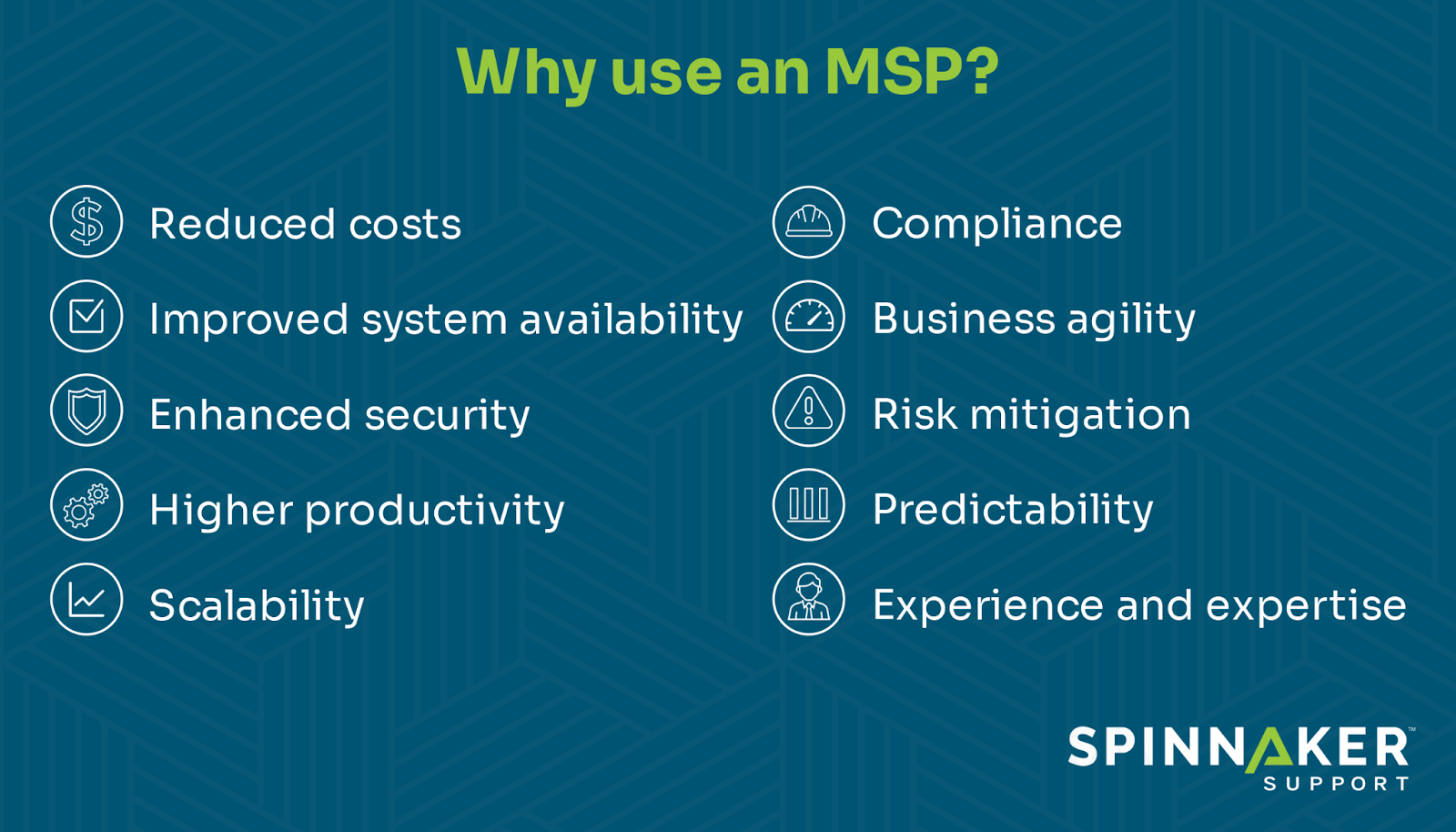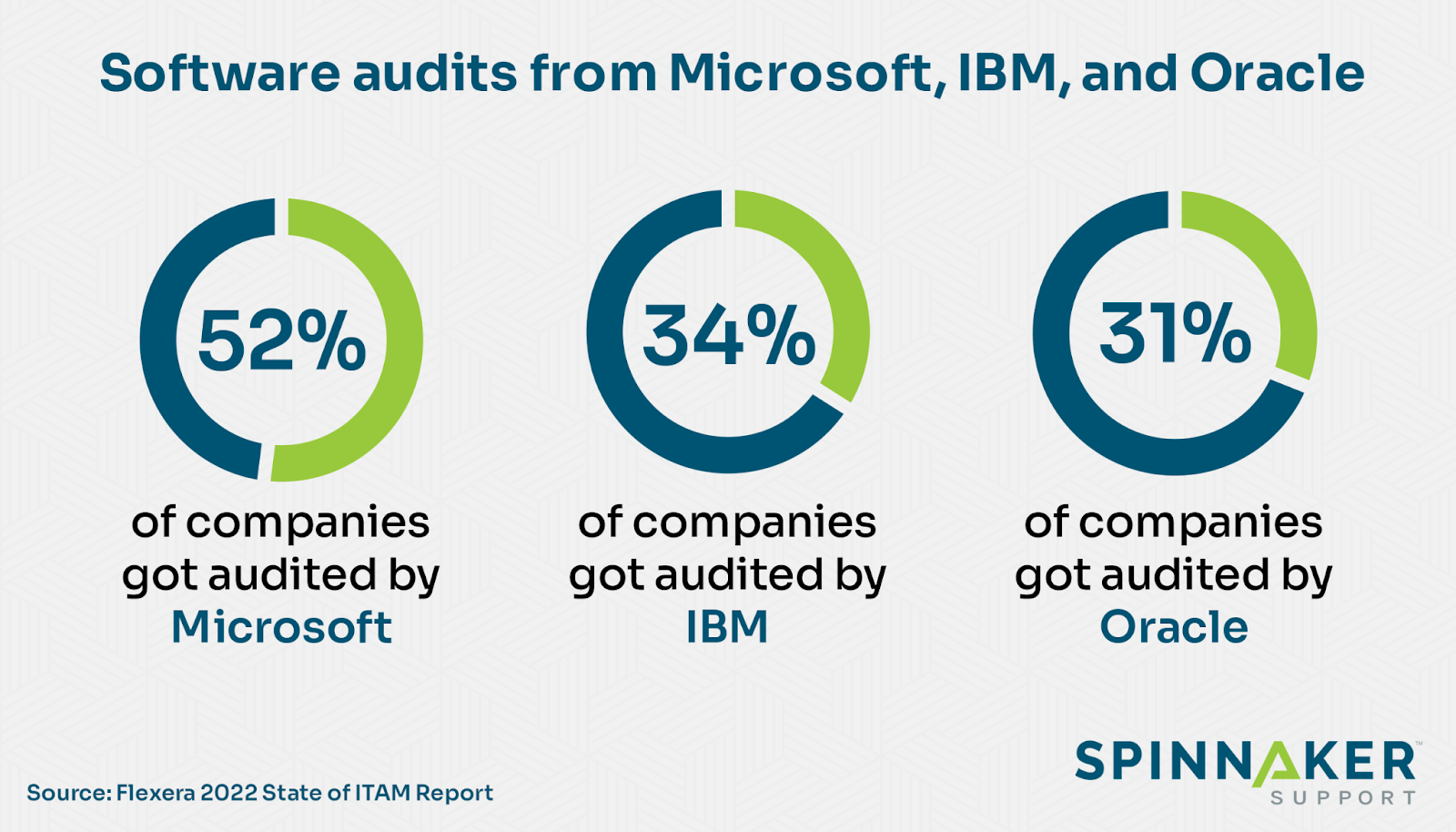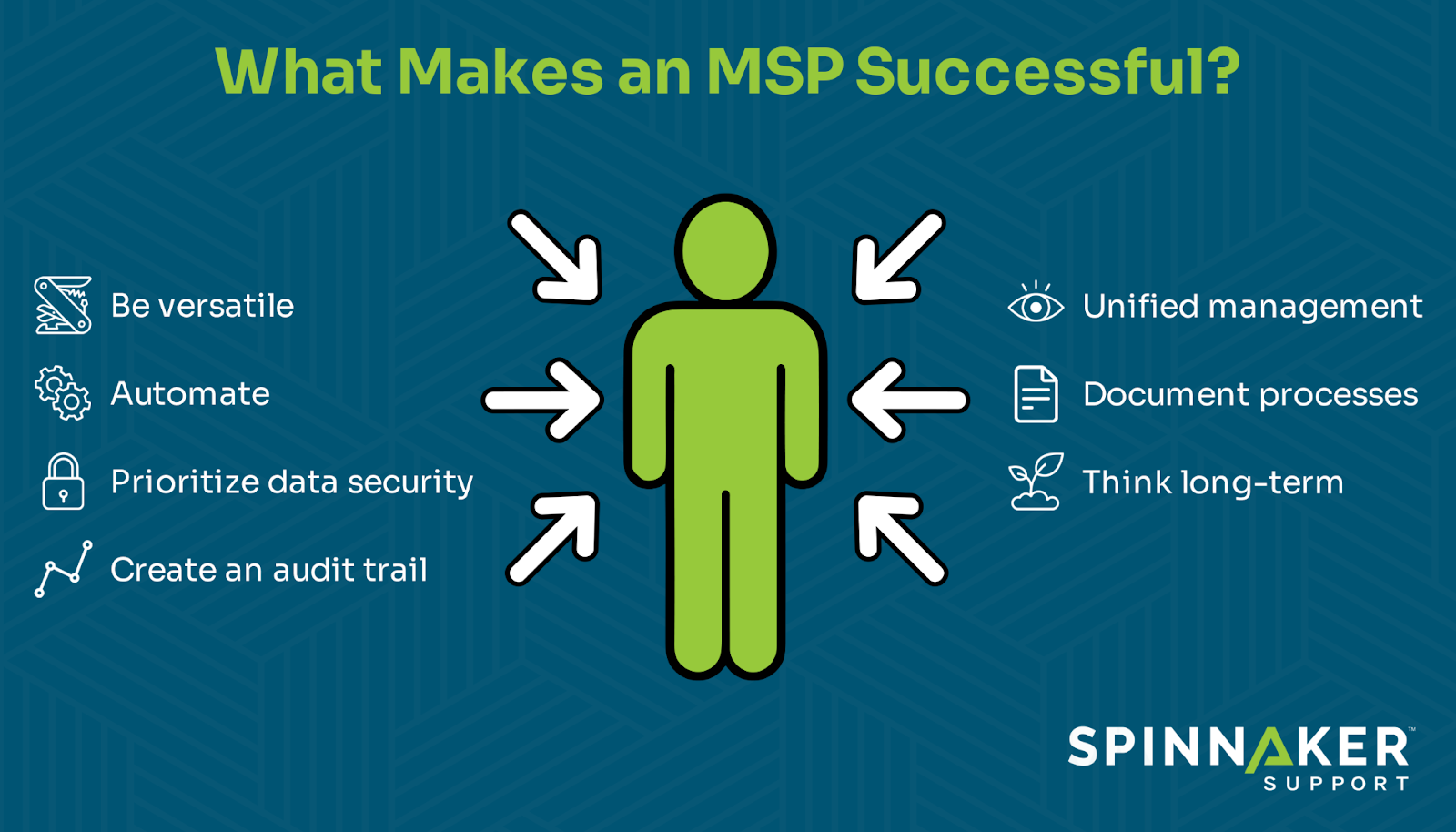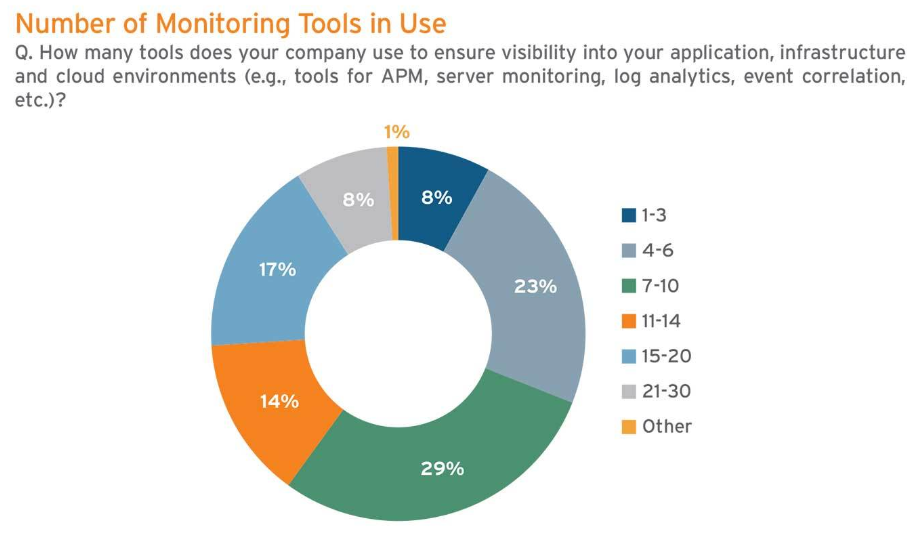
Businesses waste at least a third of their IT budgets on products and services that are either underused or not used at all. This is a problem no matter the size of the company: unchecked sprawl for larger companies and teething problems for smaller ones.
At this level of waste, reining in spending would require expert intervention. However, putting together an internal team for this purpose isn’t always an option, and that’s why external expertise exists.
Enter the managed services model.
This article will get you up to speed on everything you need to know about managed services, including why you would need them and the best practices to implement for success.
What is the managed services model?
The managed services model is one where a business offloads IT-related functions to an external company, like Spinnaker Support, called the managed service provider (MSP).
We split our managed services into two areas:
- Technical Managed Services (TMS): This area focuses on operational support for infrastructure and technology that includes databases, operating systems, middleware, and platforms
- Application Managed Services (AMS): This focuses on developmental and functional support for people who use business applications
As an example, let’s take a look at our Salesforce Sales Cloud managed services. We provide end-to-end solutions to technical aspects such as system changes and updates, establishing progression metrics and sales processes and creating dashboards and reports.
This way, the sales team can focus on bringing in customers without understanding how the CRM works under the hood because they don’t need to.
Why use an MSP?
Managing and maintaining your IT infrastructure to support your operations isn’t easy.

Here are some of the top reasons to use an MSP.
1. Reduces costs
By outsourcing IT operations to a managed service provider, you avoid the costs that come with building and maintaining an internal IT team.
An MSP that provides third-party support alongside its managed services can also help you realize substantial savings by moving away from first-party support. In our case, we help companies achieve 50% in immediate savings and 90% over time.
2. Ensures system availability
We provide 24/7/365 managed services and response times of under five minutes, meaning the systems you place in our care are less prone to service disruption than they’d be if you’d left them to an IT team that clocked out at the end of the day.
As soon as any issues arise, you can rest assured there’s someone on hand to address them before you even know it. Our ITIL Level 2 and Level 3 engineers are always monitoring your systems. Serious issues get escalated to Level 4 engineers, making sure your systems don’t experience avoidable failures.
3. Improves system security
The round-the-clock remote monitoring and short response times discussed above also manage security risks proactively because you’re not waiting until you detect a threat to swing into action.
An MSP also brings with it security best practices, ones that you might overlook. For example, in our bid to reduce over-reliance on vendors, we apply a Seven-Point Security Solution that covers you better than general security patches do.
By implementing these measures early on, your company won’t be stuck figuring out security, a position that leaves you catastrophically vulnerable.
4. Boosts productivity
As we’ve detailed with the example of our Salesforce Sales Cloud managed services, an MSP frees your team up to concentrate on tasks that are more in line with their core roles. We manage the tools you use and refine your processes on your behalf so you have everything you need to get results.
5. Allows for scaling
As your business grows, you’ll need to beef up your IT systems to match. Conversely, you might need to scale things down when winding down large projects or switching vendors.
In either scenario, an MSP would provide you with the elasticity you need to scale your IT systems up or down, e.g., product decommissioning and addition.
6. Maintains compliance
A lot of the services we manage are subject to audits and regulations from the vendor, and we make it easier for companies to comply. In fact, our managed service offerings cover Microsoft and Oracle products, two companies that conduct the most audits.

We also understand that compliance isn’t just checking boxes, which is why we also offer compliance assurance and audit defense services, with a 95% win rate on Oracle alone.
7. Enhances business agility
You can more effectively respond to market changes and/or adopt new technology when you use the managed services model. An MSP is a partner whose job is to identify and implement processes and systems that give you a competitive advantage.
8. Mitigates risk
As you might have gathered thus far, MSPs are adept at risk assessment and management. We evaluate each client’s risks right at the start and continue to do so for the duration of the partnership. We advise companies on how to harden their systems to reduce their risk surface on financial, operational, strategic, and compliance fronts.
For example, we manage strategic risks by keeping clients from locking themselves into agreements with vendors that would hurt their operations, e.g., with slow-response times services and unreasonably high fees.
9. Offers predictability
You have a better idea of how much you’re going to be spending on your IT needs because a service fee is more predictable than staffing expenses. Our multi-year agreements structure the relationship in a way where you know what to expect in the long term far more accurately than you would with a traditional IT team.
10. Provides access to expertise
An MSP gives you easy access to a team of professionals like you’d get with an internal IT department, in a way where the team isn’t abstracted like when offshoring.
Aside from engineers and support technicians, we also have consultants who can help you improve your business processes in ways that traditional IT teams often can’t.
What makes an MSP successful?
In order to realize the benefits detailed above, your MSP will need to implement a set of best practices to ensure they’re operating at the highest level they can.

A successful MSP has all the following qualities.
1. Be client-centric
Companies turn to MSPs to make IT easier, and the relationship won’t last long if they’re not at the center of things. Spinnaker Support is client-centric before we’re anything else, which is why our customer satisfaction rating is nearly 100%.
One way we set ourselves apart in this regard is by avoiding traditional service-level agreements in favor of our Ultimate Support Guarantee. With these terms, we place our customers’ needs first and then work to meet them rather than forcing them to accommodate us.
2. Be versatile
A successful MSP should be a single-vendor solution that can manage a wide range of products and services because companies don’t just use one thing for everything.
Our managed services cover major software providers, like Microsoft, Oracle, JD Edwards, SAP, and Salesforce, whose software is used across a broad spectrum of industries. What’s more, we’re one of the only third-party support service providers that offer AMS, TMS, and consulting services under one roof.
By not confining ourselves to a single niche or provider, we also have more insights into which solutions would work best for your business and can help you adopt them.
3. Automate
Automation is always a surefire way to boost efficiency in any ecosystem, and it’s no different for MSPs. We find ways to improve processes wherever we can, both ours and yours. For example, if you use Salesforce, we can help you automate processes between other enterprise systems like Oracle and SAP.
4. Prioritize data security
A breach could expose trade secrets, introduce vulnerabilities, and damage a company’s reputation for good, which is why we prioritize data security in the systems we handle. We go about this by following our previously mentioned Seven-Point Security Solution:
- Custom risk review
- Attack surface reduction
- Compliance audit support
- Vulnerability support
- Security resource library
- Proactive security tooling
- Risk assessment bulletin
All these work together to map out and strengthen your environments and implement comprehensive security incident response and threat intelligence measures.
5. Create an audit trail
There’s a persistent myth that switching to managed services will trigger an audit. The truth is that your chances of getting audited will remain the same, and you might actually need an MSP if you hope to get through them safely.
We help you stay ready in case you get audited by logging all relevant data, statistics, and metrics that the vendor might require. This way, you’re more prepared if the auditors come knocking, and you stand a better chance of winning with our audit defense services.
6. Use a unified management strategy
Around 29% of companies use between 7 and 10 tools for visibility into their applications, systems, and environments.
We avoid doing things this way and opt for a unified approach instead, reducing sprawl while increasing visibility across your systems.
8. Document processes
An MSP documenting relevant information, especially as it relates to repeatable processes, is a step in the right direction for transparency. The client knows what’s going on in the background, and they can use the information gathered to improve their business.
We also use this information to build a comprehensive knowledge base for each client that streamlines troubleshooting and support efforts.
9. Think long-term
When dealing with software, it’s easy to get distracted by the shiniest new thing in the industry. An MSP should be in it for the long haul, and we avoid this pitfall by distinguishing between what’s currently popular versus what’s right for the business in the long term.
For example, we often find that maintaining legacy software is more practical than “upgrading” to a newer version. When you’ve been operating your business with one set of tools for long enough, a vendor forcing you to change things up could have a ripple effect that you might miss if you’re looking at things in the short term.
Conclusion
Under the managed services model, companies offload their IT needs to a managed service provider (MSP). Some of the benefits of adopting this model include cost savings, improved security, productivity boosts, and better compliance. A good MSP is client-centric, versatile, and adopts efficient processes for itself and its clients.
Spinnaker Support is one of the world’s leading MSPs, providing a range of services for the most commonly used software across a wide variety of industries. If you’re ready to get started, contact us today to speak to someone about leveraging managed services for the digital transformation your company needs.



